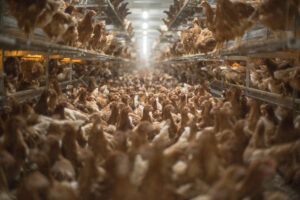CDC Sounds the Alarm on How Medicine and Agriculture Are Killing Us
Drug-resistant bacteria are causing the deaths of at least 23,000 Americans a year, a problem exacerbated by injudicious use of antibiotics in treatment of patients -- and their pervasive use in agriculture.
A new report from the Centers for Disease Control and Prevention dives deeply into two factors that are causing the deaths of more than 23,000 people a year from drug-resistant bacteria: injudicious use of antibiotics in treating patients, and their pervasive role in agriculture.
The detailed report is here, but Wired magazine has done a good job summarizing the major elements in two pieces by Maryn McKenna, a journalist and author of “Superbugs,” among other works. According to her first article:
The agency’s overall — and, it stressed, conservative — assessment of the problem:
– Each year, in the U.S., 2,049,442 illnesses caused by bacteria and fungi that are resistant to at least some classes of antibiotics;
– Each year, out of those illnesses, 23,000 deaths;
– Because of those illnesses and deaths, $20 billion each year in additional healthcare spending;
– And beyond the direct healthcare costs, an additional $35 billion lost to society in foregone productivity.
“If we are not careful, we will soon be in a post-antibiotic era,” Dr. Tom Frieden, the CDC’s director, said in a media briefing. “And for some patients and for some microbes, we are already there.”
In agriculture, particularly the dosing of livestock, Frieden told reporters that the use of antibiotics in livestock has had a direct effect on increased illness among people.
“For the whole pathway, we need to address from farm to table,” Frieden said. “And that at various different steps, there are things that can be done to increase or decrease the likelihood of infections generally and resistant infections specifically. We also know that there are specific situations in which the widespread use of antimicrobials in agriculture has resulted in an increase in resistant infections in humans.”
Even more chilling: The CDC’s declaration that there is insufficient monitoring of drug-resistant illnesses, making it difficult to fully grasp the extent of the issue, and the damage. It called for better monitoring, better prevention through vaccinations and hospital practices, better food production and food handling, a more judicious use of antibiotics in both patients and agriculture, and designing better antibiotics and tests to more quickly deal with resistant organisms. According to the report:
Antibiotics are widely used in food-producing animals, and according to data published by FDA, there are more kilograms of antibiotics sold in the United States for food-producing animals than for people… This use contributes to the emergence of antibiotic-resistant bacteria in food-producing animals. Resistant bacteria in food-producing animals are of particular concern because these animals serve as carriers. Resistant bacteria can contaminate the foods that come from those animals, and people who consume these foods can develop antibiotic-resistant infections. Antibiotics must be used judiciously in humans and animals because both uses contribute to not only the emergence, but also the persistence and spread of antibiotic-resistant bacteria.
—Posted by Scott Martelle
.
Your support matters…Independent journalism is under threat and overshadowed by heavily funded mainstream media.
You can help level the playing field. Become a member.
Your tax-deductible contribution keeps us digging beneath the headlines to give you thought-provoking, investigative reporting and analysis that unearths what's really happening- without compromise.
Give today to support our courageous, independent journalists.






You need to be a supporter to comment.
There are currently no responses to this article.
Be the first to respond.